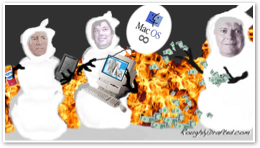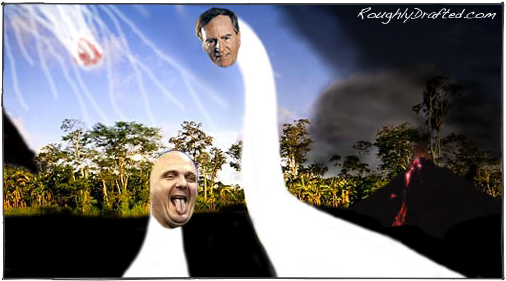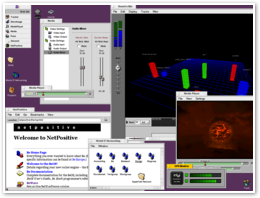
Platform Crisis: The Lazy Dinosaur 5
1995: Apple's Second Wind
Apple was becoming a dinosaur. After a decade of rapid growth, the company's size was now a problem: it inhibited change and smart thinking. Along with its size, the company had developed a certain arrogance that exuded from its products: everything seemed overpriced and either impractical or just not very competitive.
The out of control Copland project and the Taligent fiasco weren't helping anything, but the real problem was that Apple wasn't selling more Macs. Consumers increasingly had little reason to buy them. Apple didn't desperately need a new OS to compete against Windows 95, it just needed a desirable product at a competitive price to sell against the PC.

While PowerPC gets a bad rap by historical revisionists, it actually kept Apple alive by providing exactly that. After releasing the new PowerMacs, sales and growth rebounded. Apple also increased its efforts to lower prices, using cheaper IDE CD-ROM and hard drives in Macs in place of the more elegant but expensive SCSI drives.
These steps helped to bring 1995's sales to a new peak of 4.5 million Macs, and gave Apple 11.5% of the US market at a time when domestic sales represented more than half of Apple's volume.
Throughout 1995, Spindler fielded ongoing acquisition talks with a number of companies, including IBM, Oracle, Phillips, and Sun. Apple was still making a lot of money, and Spindler wanted to capitalize on Apple's rebound by selling off Apple at a premium. IBM offered a premium, but Spindler thought he could get more. He was wrong.
1996: Crisis Explosion
Apple wouldn't again meet its 1995 high water mark in Macs sales for another decade. Part of the reason was new competition from Windows 95, but Apple’s new cloning efforts were also cannibalizing Mac sales, eating up Apple’s profits on the high end, and leaving the company with a glut of underpowered Mac Performas sitting unsold on shelves at Sears.
Microsoft had delivered Windows 95 at the end of the year, and followed up with Windows NT 4.0 in the summer of 1996. It didn't matter that Apple had significant market share and good products to sell. The real problem was product perception: to the public, it appeared Apple had little new to offer.
Stoked by a massive ad campaign for Microsoft’s revised Windows environment running on DOS, the press went wild for Windows 95 and waited for Apple's news on Copland.
The truth was progressively revealed that Apple's plans to deliver a Copland System 8 and Gershwin System 9 were not going to happen.
Just when sales of PCs fueled by Windows 95 began to explode, Apple was brilliantly announcing that it had no deliverable plan for a future Mac operating system.
While the second generation of PowerMacs were fast and offered a streamlined PCI architecture superior to most PCs, the announcement cast doubt over Apple’s future prospects; sales in 1996 nose dived.
It also didn’t help matters that the new PowerMacs saw little advertising and were under attack by Apple’s rival clone licensees.
Dazed and Confused
Even worse, every other software project at Apple seemed to be falling apart as well. QuickDraw GX had stalled, PowerTalk was abandoned, and future plans for QuickTime were uncertain, with no updates on the horizon.
Mac developers were increasingly frustrated by Apple's lack of consistent direction and inability to ship. Amid all the cancelations, Apple shifted its attention to other projects, including OpenDoc.
When Apple began talks to buy BeOS the next year, it became obvious that its internal development efforts were an unmitigated disaster. Why develop for a company unable to present a stable platform or even a future plan?
BeOS, while offering some interesting new interface ideas and capable of a great demonstration, couldn't even print, had no multiuser capabilities, and no serious software base.
If Apple had to go outside to find a basic shell of an operating system to begin development work on, it was clearly in serious trouble.
Rumors began resurfacing that Sun might buy Apple; Sun was also supposed to be interested in buying out the Newton. Larry Elision of Oracle planned to buy Apple and use the Mac to deliver his vision of a Network Computer future.
How did Apple fall from being a rich and comfortable leader to being a desperate surplus heap, apparently only suitable for salvage?
This Article
This Series










Wednesday, November 29, 2006


 Bookmark on Del.icio.us
Bookmark on Del.icio.us Discuss on Reddit
Discuss on Reddit Critically review on NewsTrust
Critically review on NewsTrust Forward to Friends
Forward to Friends
 Get RSS Feed
Get RSS Feed Download RSS Widget
Download RSS Widget





